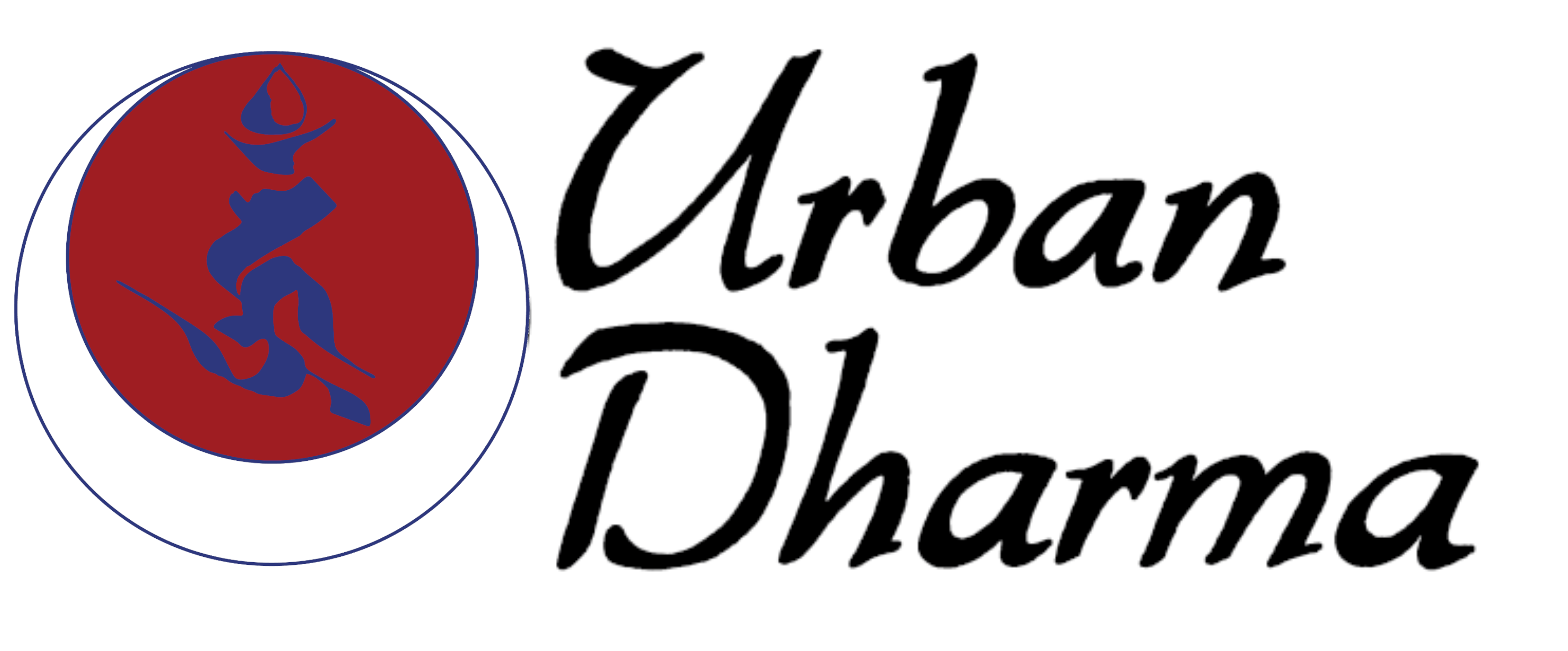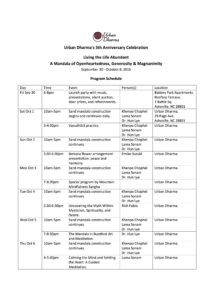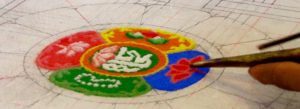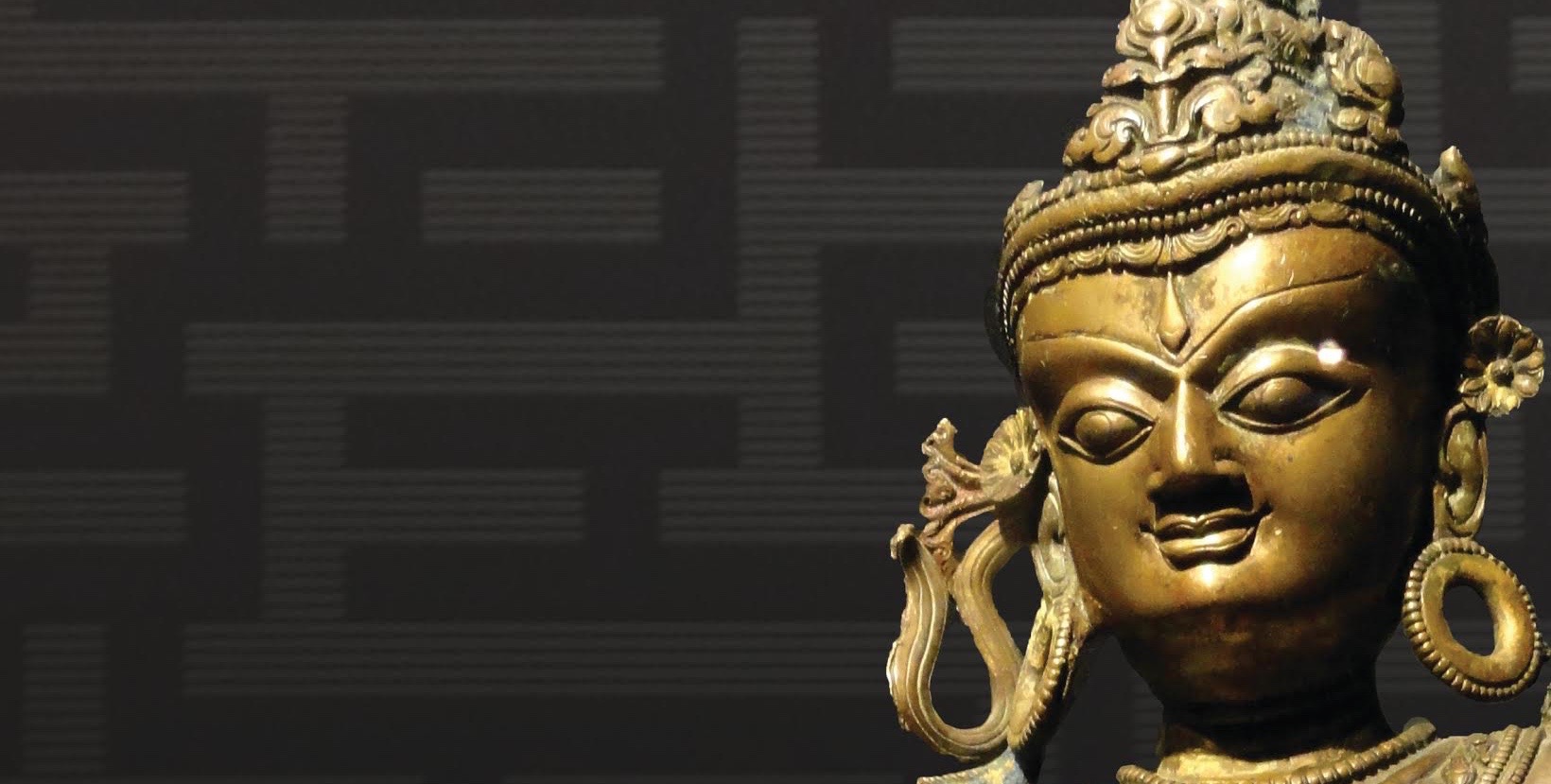
Fifth Anniversary Celebration
September 30 - October 8Celebrate with a party
Our Fifth Anniversary Celebration will begin with a Launch Party on Friday, September 30, 6-8 pm at the Roof Terrace of the historic Battery Park Hotel (now Apartment), across from Urban Dharma. The various groups that share our space – Nourishing the Roots (a Drikung Kagyu sangha), and Mountain Mindfulness Sangha (a Thich Nhat Hanh tradition sangha), among others – will come together to celebrate.

It will be an evening of stories, music, food, silent auction, and door-prizes. Included in the silent auction and raffle prizes are antique pieces and sacred objects from Dr. Lye’s personal collection (an early 20th century, 18″, wood statue of Laozi/Lao-tzu, a 9″ Vajradhara from Dr. Lye’s shrine, a stupa containing soil taken from all 14 birthplaces of the 14 Dalai Lamas), original, superbly executed, signed Tibetan artwork from Nepal, original artwork by accomplished artist friends of Urban Dharma, Peruvian Arpillera fabric wall art, Mola art panels by the Kuna Indian Tribe of Panama, signed Charleston 1965 Gullah print by Elisabeth O’Neil Verner, exquisite necklaces, Tibetan woodblock prints, and more!
That evening, we will also launch a new commitment of Urban Dharma to help support a community of exile Tibetan Buddhist monks and nuns living in India (Drikung Kagyu Institute in Dehra Dun) by contributing to their annual medical fund. More information to share on this exciting project at the party!
Lectures, forums & teachings
Vasudhārā Sand-Mandala of Bounty
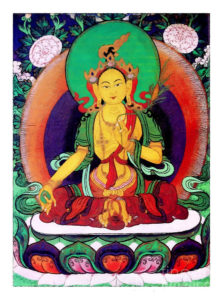
The spiritual heart of UD’s upcoming 5th Anniversary celebration will be the principle of Abundance & Generosity as embodied by Vasudhārā – “The Lady of Bounty,” “Bearer of Treasures,” & “Shower of Gold.” As such she is also identified closely with Bhūmidevī – the Earth Goddess as the earth is the source of all abundance, agricultural fertility and thus wealth. Our sand-mandala will be a Vasudhārā mandala – a unique mandala where the Lady sits in the center and emanating out in the four directions are the Lords of Abundance – White Jambhala riding on a dragon, Yellow Jambhala in the regal pose, 6-armed Red Jambhala with Kurukulle in his heart and Black Jambhala with a wrathful gait.
Throughout the week, the community is invited to come see the progress of the construction of the sand-mandala by Khenpo Chophel (of the Three Rivers Tibetan Cultural Center, Pittsburgh), Lama Konchok Sonam (of Drikung Meditation Center, Boston) and our own Dr. Lye. Grain by grain, moment by moment the “divine palace” of Vasudhārā will be built with devotion, grace, concentration and patience. Construction of the sand-mandala will begin with a simple ritual starting at 10 am on Saturday, Oct. 1. The rest of the day and morning of Sunday, Oct. 2 will involve Khenpo Chophel masterfully drawing the grid of the mandala on the wooden surface of the mandala. The use of colored sand will probably begin on Sunday afternoon. From Saturday Oct. 1 to Thursday Oct. 6, the lamas will be working from 10 am to noon, and 2 to 5 pm.
On this blessed occasion, we will also be introducing a very special tantric sadhana practice of Vasudhārā and the four Jambhalas known as Dispeller of Poverty: Sky Treasury of Jewel Grains composed in the 17th century by the great First Chungtsang Rinpoche of the Drikung Kagyu Lineage, Rikzin Chokyi Drakpa. Towards the end of the week we will be practicing this sadhana which consists of outer, inner, secret and essence practices.
On Friday Oct. 7 the completed sand-mandala will moved from the front gallery of Urban Dharma into the temple space, to be placed in a special shrine. That evening (7-9 pm), Khenpo Chophel, assisted by the other two lamas, will confer the Vasudhārā “authorization and blessing” (Tib. jenang). Saturday Oct 8, led by the lamas, we will practice Dispeller of Poverty: Sky Treasury of Jewel Grains to invoke the blessings of the Lady and Lords of Bounty – Vasudhārā and the four Jambhalas – and to cause the blessings to remain inseparably in each grain of sand of the completed mandala as well as a number of specially prepared amulets and relic-boxes (Tib. gau) that will be made available to participants. At 4:30 pm, the sand-mandala will be dissolved and offered into the French Broad River, allowing the river to take the blessings into the ocean, thus distributing the blessings universally without any partiality or limits.
Vasudhārā with the Four Jambhalas
A Mandala of Openheartedness, Generosity & Magnanimity
For our 5th Anniversary Celebration, we have commissioned the translation of a very special but yet rarely practiced sadhana (practice-manual) of the Lady of Bounty, Vasudhārā, composed by the great Drikung Kagyu master, Rikzin Chökyi Drakpa C (1595-1659). He was the First Chungtsang Rinpoche, and considered the emanation of the Buddha of Wisdom, Mañjuśrī. He was both a great scholar as well as a realized master who spent his life in retreat, composing texts, receiving and conferring transmissions, performing protective rituals to be benefit others. Among his admirers were the Fifth Dalai Lama (1617-1682), who had great faith in Rikzin Chökyi Drakpa’s great powers. Appropriately, he is often referred to as “kunkhyen” (which means, “all-knowing”).
Among his voluminous collection of works is a Vasudhārā-based sadhana known as Dispeller of Poverty: Sky Treasury of Jewel Grains. Dispeller of Poverty: Sky Treasury of Jewel Grains is a unique sadhana with Vasudhārā in the center of the mandala and emanating out from her are the four Lords of Wealth – White Jambhala in front of her, Yellow Jambhala to her right, Red Jambhala to her back and Black Jambhala to her left. Often, when female buddhas are in the center of a mandala, the deities emanating out tend to be female as well (such as the mandalas of Vajrayogini or Kurukulle). In this case, she is the principal deity attended by the four Jambhalas.
Structurally, this sadhana has four parts to it – outer, inner, secret and innermost secret. The outer practice is the practice of offering water, the inner practice relies on a torma, the secret practice is the practice of amulet boxes (Tib. ghau), and the secret innermost is the practice of the “citta sky yoga.” While most Jambhala traditions involve the making and consecration of wealth and abundance vases (Tib. norbum or yangbum), in this text instructions are given for preparing amulet boxes instead. As far as we know, this is not at all a common tradition and therefore we feel fortunate to be able to celebrate our Fifth Anniversary with this unique tradition originating with the all-knowing Rikzin Chökyi Drakpa.
Opportunities to Help Sponsor the Mandala of Vasudhārā
It takes innumerable causes and conditions for an event such as our Fifth Anniversary Celebration to manifest. Among those causes and conditions is financial resource. We are dependent on the generosity and magnanimity of family, friends, well-wishers, community members and even strangers to offer the programs we have scheduled for the 9 days.
Unlike in Asia where Buddhism has a strong and ancient support base, as a small Buddhist temple on the Appalachian Mountains of Western North Carolina we need all the help we can financially to exist and to continue to offer others the gift of Dharma. We therefore appeal to everyone to help us pay for what we have planned for this celebration. In this way, we can all share in the great blessing and merit that would undoubtedly ensue from these auspicious activities.
We will have three types of amulet boxes (Tib. ghau) prepared and consecrated during our Vasudhārā-Jambhala sand-mandala and puja and they are available for sponsorship by anyone inspired to do so. Two of these amulet boxes are in the traditional Tibetan ghau while the third is ideal for wearing around one’s neck.
Suggested Donation for Sponsoring Amulet-Boxes
20 Larger (3.5″ ) Ghau – $200 (We NO longer have any left)
18 Smaller (3″) Ghau – $150 (We NO longer have any left)
108 Amulet (1.5″ X 2″ X .25″) – $25 (Please contact us if you are interested still in having an amulet)
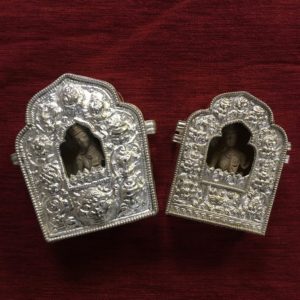
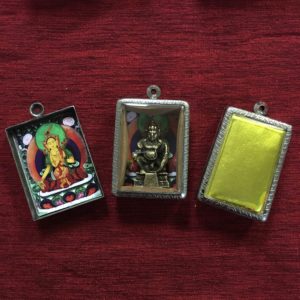
None of these sacred objects are “for sale.” Instead, we offer them to anyone as a gesture of our thanks for your support of Urban Dharma and all the activities we carry out to serve our community and all mother sentient beings. All these three types of amulet-boxes offered here ultimately carry the same blessings, its only that conventionally they contain slightly different blessing substances. The larger and smaller ghaus can be placed on your personal home shrine, serving as the “support” for the Buddhas – and in particular the deities of abundance and wealth – to manifest and bless us. You can also use it as a “travel shrine” by using a clean and special – such as brocade – cloth to wrap it and take it with you when you are on the road. It will offer swift protection (since Vasudhārā is a form of Tāra) and inspire you to practice generosity. When our heart is gladdened by generosity, then we will enjoy true satisfaction and blessing. The small amulet can be worn hanging on your neck and it too is a source of protection and blessing. Wearing it, we should become more watchful of the negative emotions of miserliness, craving and “not-enoughness,” and be open to the blessings of open-heartedness, generosity and magnanimity.
If you are interested in sponsoring any of these amulets, please contact us at info@udharmanc.com so that we can reserve one – or more – for you! You can pick them up after the dissolution of the Vasudhārā-Jambhala sand-mandala on October 8 or we can mail it to you if you are not local and can’t be here personally to collect your amulet box(es).
We also hope to have several ghaus donated for a general drawing on the night of the Vasudhārā Empowerment (October 7, 7-9 pm). Anyone who would like to “invite” a ghau but is currently unable to offer the suggested donation can enter their name for this drawing and stand a chance to win one – if you have the karma for it! If you would like to help donate to this pool of ghaus, please contact us too.
Larger & Smaller Ghau
Each of these ghaus contains a one-of-its-kind, Vasudhārā clay statue which we specially commissioned for this occasion. A new casting-mold was made based on an old depiction of the goddess we provided the statue-makers. Each statue is carefully made with the following blessed substances in them:
- A mini central-channel (Tib. sokshing) made from the Swayambunath Stupa sokshing. [Note: During the recent repairs to the Swayambunath Stupa after the devastating earthquake of 2015, the ancient sokshing in that stupa was replaced. We are so fortunate to be gifted that and have created match-stick sized mini sokshings for these statues.]
- Consecration barley (Tib. rabney dre) that has been blessed by many high-lamas and traditionally used for consecrating sacred image. Offered to us by Rinchenling Monastery in Nepal.
- Dharma-medicine (Tib. mendrup) that contains many blessed substances. Offered to us by Garchen Rinpoche and Nubpa Rinpoche of Drikung Kagyu Lineage.
- Sacred soil obtained from a holy-site of Vasudhārā and Vajravārāhī in Kathmandu. [To get “permission” from the goddesses and the local protector-deities to take the soil, we had to arrange for special pujas performed by Newari vajracharyas. Very auspicious signs appeared during the pumas – including an image of Vasudhārā that can be seen forming in the burnt-offerings.]
- Blessed puffed barley from Newari Buddhist temples in the Kathmandu.
- Soil, sand and wood from the Boudhanath Stupa. [Note: The Boudhanath Stupa was damaged during the earthquake of 2015 and during the renovations these substances were offered to devotees and pilgrims.]
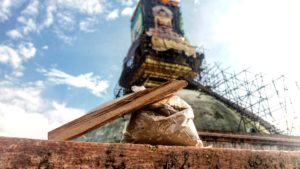
Wood & soil from the Boudhanath Stupa
Aside from the clay Vasudhārā statue, each of the ghaus will also contain the following:
- A small fragment of Milarepa’s (ca. 1052-1135) cotton shawl from the Lapchi snow mountain. [Note: This most precious of relics was offered to us by Nubpa Rinpoche of Drikung Kagyu Lineage.]
- Bits of the main Three Roots torma used by H.H. Taklung Tsetrul Rinpoche for conferring the entirety of the Rinchen Terdzod Empowerments at Mindrolling Monastery from Nov 2008 – Mar 2009. [Note: 787 empowerments were conferred by His Holiness during that transmission and this was the main Three Roots torma used during the entire period.]
- Mani-pills (Tib. mani rilbu) from H.H. the Dalai Lama.
- Mani-pills from Drigungtil Monastery in Tibet, Guru Rinpoche pills from Terdrom Nunnery in Tibet, Dharma-medicine from H.H. Drikung Kyabgon Chetsang.
- Karmapa black-pill relics from Lake Namtso in Northern Tibet. [Note: These are naturally-arising dark pills that wash up on the shores of Lake Namtso, the largest salt-water lake in the world. The 3rd Karmapa, Rangjung Dorje (1284-1339) threw a handful of his Dharma-pills into the lake and ordered the protectors of the lake – in particular Dorje Gurdak – to guard these pills that will ever increase so that they can benefit beings in the future. It is said that each of these pills is the equivalent of a buddha-relic and should be used to consecrate statues.]
- A robe-relic from the late Vajradhara Gelong Tenzin Nyima Rinpoche, the retreat-master (Tib. tripön) at Drigungtil Monastery in Tibet.
- Various incenses, herbs and medicines collected from all the major holy mountains in the Himalayan region.
- A mini blessed statue of Jambhala, bathed in sandalwood oil.
- Mantras and dhāraṇīs of the wealth and abundance deities.
- Consecration barley from Samye Monastery, Tibet – the oldest monastery in Tibet.
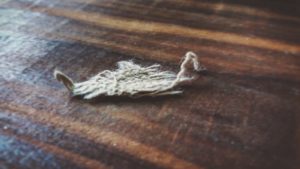
A piece of Milarepa’s Cotton Shawl
Amulets for wearing
We have prepared a total 108 small, wearable amulets of Vasudhārā-Jambhala and each of them contains the following:
- Blessed mini statue of Jambhala bathed in sandalwood oil.
- Picture of Vasudhārā.
- Gold-leaf for good interdependence/luck (Tib. tendrel).
- Consecration barley from Samye Monastery, Tibet & from Rinchen Ling, Nepal.
- A small fragment of Milarepa’s cotton shawl.
- Blessing-pills from various great lamas.
- Karmapa black-pill relics from Lake Namtso in Northern Tibet. [Note: These are naturally-arising dark pills that wash up on the shores of Lake Namtso, the largest salt-water lake in the world. The 3rd Karmapa, Rangjung Dorje (1284-1339) threw a handful of his Dharma-pills into the lake and ordered the protectors of the lake – in particular Dorje Gurdak – to guard these pills that will ever increase so that they can benefit beings in the future. It is said that each of these pills is the equivalent of a buddha-relic and should be used to consecrate statues.]
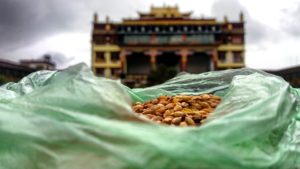
Consecration barley from Rinchenling Monastery
If you are interested in sponsoring any of these amulets, please contact us at info@udharmanc.com so that we can reserve one – or more – for you! You can pick them up after the dissolution of the Vasudhārā-Jambhala sand-mandala on October 8 or we can mail it to you if you are not local and can’t be here personally to collect your amulet box(es).
